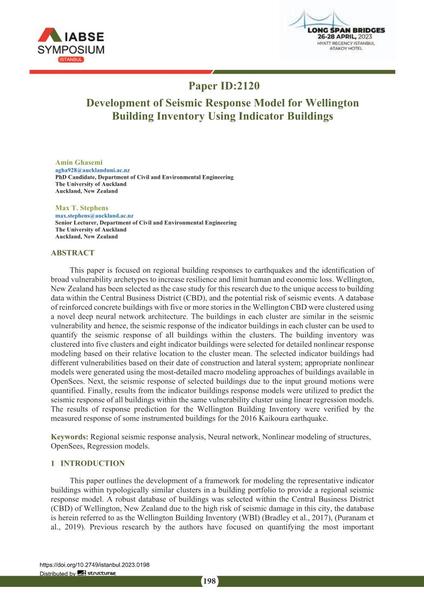Development of Seismic Response Model for Wellington Building Inventory Using Indicator Buildings

|
|
|||||||||||
Détails bibliographiques
| Auteur(s): |
Amin Ghasemi
(PhD Candidate, Department of Civil and Environmental Engineering The University of Auckland, Auckland, New Zealand)
Max T. Stephens (Senior Lecturer, Department of Civil and Environmental Engineering The University of Auckland, Auckland, New Zealand) |
||||
|---|---|---|---|---|---|
| Médium: | papier de conférence | ||||
| Langue(s): | anglais | ||||
| Conférence: | IABSE Symposium: Long Span Bridges, Istanbul, Turkey, 26-28 April 2023 | ||||
| Publié dans: | IABSE Symposium Istanbul 2023 | ||||
|
|||||
| Page(s): | 198-204 | ||||
| Nombre total de pages (du PDF): | 7 | ||||
| Année: | 2023 | ||||
| DOI: | 10.2749/istanbul.2023.0198 | ||||
| Abstrait: |
This paper is focused on regional building responses to earthquakes and the identification of broad vulnerability archetypes to increase resilience and limit human and economic loss. Wellington, New Zealand has been selected as the case study for this research due to the unique access to building data within the Central Business District (CBD), and the potential risk of seismic events. A database of reinforced concrete buildings with five or more stories in the Wellington CBD were clustered using a novel deep neural network architecture. The buildings in each cluster are similar in the seismic vulnerability and hence, the seismic response of the indicator buildings in each cluster can be used to quantify the seismic response of all buildings within the clusters. The building inventory was clustered into five clusters and eight indicator buildings were selected for detailed nonlinear response modeling based on their relative location to the cluster mean. The selected indicator buildings had different vulnerabilities based on their date of construction and lateral system; appropriate nonlinear models were generated using the most-detailed macro modeling approaches of buildings available in OpenSees. Next, the seismic response of selected buildings due to the input ground motions were quantified. Finally, results from the indicator buildings response models were utilized to predict the seismic response of all buildings within the same vulnerability cluster using linear regression models. The results of response prediction for the Wellington Building Inventory were verified by the measured response of some instrumented buildings for the 2016 Kaikoura earthquake. |
||||
